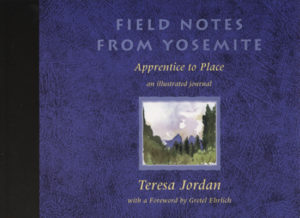View Sketchbook Pages
 From the Introduction: Dorothee said, “Happiness is such a distinct state.” We were halfway up Mount Hoffman, taking a rest with our backs against the craggy trunks of mountain cedars above an alpine meadow, gazing off toward Half Dome. With our friend Diana, we had set up base camp at May Lake the night before, and now the three of us were basking in the simple grace of being healthy and strong and together under the generous September sun in the High Sierra. Happiness is a state apart, something that seems to tingle through every cell in the body. We felt alive, present, completely at home.
From the Introduction: Dorothee said, “Happiness is such a distinct state.” We were halfway up Mount Hoffman, taking a rest with our backs against the craggy trunks of mountain cedars above an alpine meadow, gazing off toward Half Dome. With our friend Diana, we had set up base camp at May Lake the night before, and now the three of us were basking in the simple grace of being healthy and strong and together under the generous September sun in the High Sierra. Happiness is a state apart, something that seems to tingle through every cell in the body. We felt alive, present, completely at home.
But of course we were not at home. In fact we had gone to great lengths to leave home in order to gather here, Diana coming from Montana, Dorothee and I from Utah. Like millions of others each year, we had come to a National Park to relax, unwind, and reconnect with nature, which was to say with a simpler side of ourselves. Following in an American Tradition that traced back through people such as John Muir and Henry David Thoreau but had roots in the Bible and other sacred texts, we had turned to the wild for regeneration.
Like almost everyone else I know, I juggle a myriad of responsibilities and deadlines and often find myself in a state of near panic. Almost every day, I run into one friend or another who answers the query, “How are you?” with a litany of overwork, straining to pick her way through what the writer Kim Stafford calls a “pomegranate of impossible tasks.”
To try to renew a sense of balance, an increasing number of us escape to the National Parks. While our population has not quite doubled in the past 50 years, our use of National Parks has increased by over eight and a half times. For the past several years, annual visitation has edged toward the three-hundred million mark, “as if,” in the words of the New York Time, “every man, woman and child in the country visited at least one park a year.”
Behind this mass exodus from daily life is a desire to mark out a few days where we can put our lives on hold and seek something more primal, where our choices are fewer and the fax and the email and the cell phone don’t sound their little alarms. If we have had our heads down, blindly following something — even work we love — here in the wild we throw back our shoulders, take a big breath, and look out to the far horizon. We challenge ourselves physically and find that we have not turned entirely to mush. We reconnect with the natural world and feel a childlike delight in the beauty of even its smallest details: the sueded green moss at the base of a tree; the ancient twist and sheen of roots; the smooth comfort of a river-polished stone that fits perfectly in the cup of a hand. We breathe in the clear brace of early morning, shriek at the icy shock of a mountain pond, melt into the warmth of a boulder in the afternoon sun. And then we go back to our “normal” lives, and the stress starts all over again.
Life hasn’t always been split in this way. The 20th Century saw over half the world’s population working in buildings rather than outside for the first time in the history of civilization. Now, in the 21st Century, over half the world’s population lives in cities and towns rather than in the country.
I grew up on a Wyoming ranch and spent my youth outside whenever I wasn’t in school. Nature and work were intimately intertwined. But today, like the vast majority of Americans, I live in a metropolitan area and venture many miles from home to enjoy significant time out-of-doors.
“We were born of wilderness and we respond to it more than we sometimes realize,” wrote Wallace Stegner in 1990. “We depend upon wilderness increasingly for relief from the termite life we have created.” Stegner stressed this need as a reason to preserve our wild places; ironically, driven by that hunger for balance, we have flocked to National Parks and wilderness areas in such numbers that we trample them under the weight of our numbers.
“I love this place,” wrote Yosemite Park Ranger David Siegenthaler in 2000 as part of a display that emphasized the efforts being undertaken to balance the health of Yosemite’s natural resources with the ever increasing number of visitors:
“But what distinguishes love from self-indulgence? I presume this means that there are many people like me who love to be here and experience Yosemite on their own terms — and that those ‘many’ in our simple personal pursuits are collectively damaging the very things we profess to love…
So what is love to do? How does one love Yosemite in the company of so many other lovers?”
I first visited Yosemite briefly in the spring of 1999. I couldn’t wait to get back and returned for a glorious three weeks the next fall. In 2001 I came back yet again, for ten days in August. Each visit I felt more attached and at home than the time before, but also more haunted by the very quandary that Ranger Siegenthaler so eloquently ponders. If we love a place, we want to protect it. But what can a single visitor do except not visit at all?
Out of this question came others. What might happen if I started to think of Yosemite not as a place to escape to as often as possible so much as a place that could teach me ways of living that would make escape less necessary? If we need the wild for balance, isn’t there a way to incorporate the wild, or incorporate the balance we find in the wild, into our daily lives, if only for a moment each day? What might happen to our cities if we began to look at them with the same sensitivity to natural processes that comes so easily to us in Yosemite? I began to think of myself not so much as a visitor to this place as an apprentice to it, seeking out lessons that would sustain me at home.
But how could I apprentice myself to Yosemite in the too-brief spans of occasional visits? I decided to look to the work of Chiura Obata, a Japanese-born painter whose six weeks in Yosemite in 1927 kept him coming back for the rest of his life. I had begun to paint myself, on a trip down the Grand Canyon a few years earlier, and I admired Obata’s work immensely. But I also turned to him as a tutor because he so successfully carried his love of wild places with him wherever he went. Yosemite sustained him even during the years of World War II when he was interred at Topaz, a dusty relocation camp in the Utah desert.
As I studied Obata, I found myself turning, as well, to his own teachers, the trees and the rocks. And of course along the way I took lessons from others, past and present, who loved this place with a passion that translated into knowledge like the beloved ranger Carl Sharsmith; that extraordinary scholar of trees, Donald Culross Peattie; and the inimitable John Muir, the patron saint of Yosemite. Out of their teachings, this journal was born.
©2002 by Teresa Jordan
